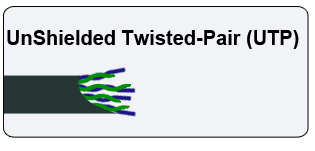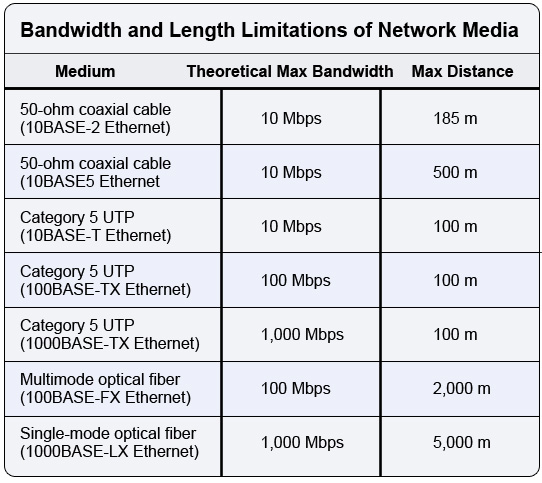There is all sorts of networking media lying around for the taking. We have copper-base media, optical fiber, and the new contender: wireless. This article covers a brief overview of each networking media type. By no means is this a complete guide to every single networking media type, but instead it is geared towards what the Network+, CCENT, and CCNA exams demands students know about networking media in general.
Copper Networking Media: Shielded Twisted-Pair
As you might’ve guessed, copper networking media uses electric signals to send and receive data over a copper medium. As far as Ethernet cabling goes, there are two main types of cable types to recognize: shielded twisted-pair (STP) and unshielded twisted-pair (UTP).
Shielded twisted-pair cable contains four pairs of color-coded wires. These pairs are each twisted together and wrapped in metallic foil. For further protection, we put yet another metallic foil over the entire bunch of pairs. Note that the below diagram does not show the standard color coding for copper media.

Shielded twisted-pair cable is incredibly resistant to noise, thanks to the twisted wiring and metallic foil. Noise from objects such as a fluorescent light can interfere with electrical signals- so you will see STP cable in these areas.
The twisted wires in particular help protect against crosstalk. When each wire is conducting a current, a magnetic field is being generated around each wire. This magnetic field can interfere with the signal on other wires, so we twist the pairs of wires to cancel out both magnetic fields. As you’ll see in unshielded twisted-pair cable we do the same thing- only UTP does not make use of the metallic foil.
There are some drawbacks to STP, however. It takes more time to install since the metallic foil needs to be grounded. And if improperly grounded, the metallic foil will act as an antenna, and draw even more noise to your cable than you would’ve had previously. Lastly, we can’t run wire as far with STP as with UTP, so STP is best suited for short wiring jobs.
Three Things to Remember about Shielded Twisted-Pair
- 1. Bandwidth is limited to 10-100 Mbps
- 2. STP is much more expensive than its UTP counterpart
- 3. Maximum cable length is short- around 100 meters
Copper Networking Media: Unshielded Twisted-Pair
Unshielded twisted-pair cable is much like shielded twisted-pair, only it lacks the extra metallic foil. This is usually more common to use, as it is less expensive and requires less work to install.

Note that there is an absence of both metallic foiling around each twisted pair, as well as the metallic coating around all of the collective wires. This would of course be less effective in stopping outside noise from interfering with our signal, but in most cases UTP works just fine.
Three Things to Remember about UnShielded Twisted-Pair
- 1. Bandwidth is limited to 10-1,000 Mbps
- 2. It is much easier to install than other media- such as fiber optic or coaxial
- 3. It is generally the least expensive
Optical Networking Media
Fiber optic cable uses modulated light to send and receive signals. This eliminates crosstalk and even provides immunity to electromagnetic interference. Fiber optic media also provides much more bandwidth capability, distance capability, and is easily installed.
Luckily, Cisco doesn’t put a lot of emphasis on optical media on exams. However, be sure commit the following to memory:
Three Things to Remember about Optical Media
- 1. Optical fiber uses light patterns to send a receive signals
- 2. Optical fiber is less affected by external signals
- 3. Optical fiber allows for longer cabling distances
- 4. Optical fiber is more expensive than UTP
Wireless Networking Media
Networking students are currently getting a break on wireless networking in exams. This is very likely to change soon, but for now, all that is really required to commit to memory are three IEEE standards: 802.11a, 802.11b, and 802.11g.
802.11a operates on a 5 GHz frequency. It offers much better data transfer speeds than 802.11b, although it doesn’t have as good as of a range. 802.11a is a poor choice when several walls or other obstructions are present between the access point and client.
802.11b operates on a 2.4 GHz frequency. It has a better range than 802.11a, but has much less capability to offer the excellent data transfer speeds that 802.11a does.
802.11g also operates on a 2.4 GHz frequency. It is a hybrid of the two previous standards: offering both excellent download speeds and excellent range. Although it isn’t technically as fast as 802.11a, it is quite close in benchmarks.
Networking Media Specifications
When you see the term 10BASE-T, do you automatically think of a cable that has a theoretical bandwidth limit of 10 Mbps, and a distance of 100 meters? If you don’t, make note that Cisco does indeed require networking students to commit this type of information to memory. But don’t worry, it is easier thank you might think.

To memorize all of the above would be quite tedious. And more than likely, it’d be forgotten within the next week. Instead, we can simply look at the networking medium name to determine its specifications. The 10 in 10BASE-T for instance, indicates its bandwidth is theoretically 10 Mbps. The T indicates that it is a twisted pair cable.
The 10 in 10BASE5 also means a bandwidth of 10 Mbps, but notice that the 5 actually tells us the maximum distance it can run: 500 meters. Obviously, a little deciphering on your part can mean less memorization.
Closing Comments
Although we could have gone much more into detail, Cisco doesn’t require general networking students to do so. The bulk of this material is useful for the Network+, CCENT, and CCNA
Got a project that needs expert IT support?
From Linux and Microsoft Server to VMware, networking, and more, our team at CR Tech is here to help.
Get personalized support today and ensure your systems are running at peak performance or make sure that your project turns out to be a successful one!
CONTACT US NOW

